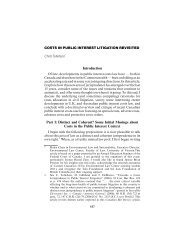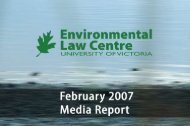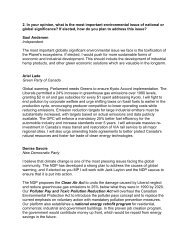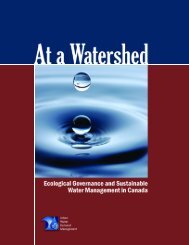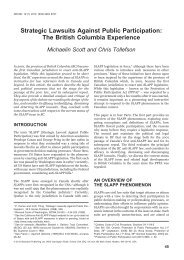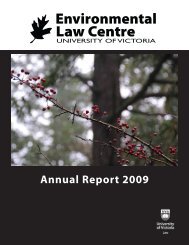Peeling back the Pavement - POLIS Water Sustainability Project
Peeling back the Pavement - POLIS Water Sustainability Project
Peeling back the Pavement - POLIS Water Sustainability Project
You also want an ePaper? Increase the reach of your titles
YUMPU automatically turns print PDFs into web optimized ePapers that Google loves.
CASE STUDY 3<br />
PHILADELPHIA THINKS BIG WITH ALL-GREEN<br />
STORMWATER MANAGEMENT PLAN<br />
Since 2009, <strong>the</strong> City of Philadelphia has been making headlines for its unconventional<br />
vision of urban stormwater management. Philadelphia’s plan for controlling combined<br />
sewer overflow, Green City, Clean <strong>Water</strong>s, is <strong>the</strong> largest green stormwater infrastructure<br />
program ever envisioned in <strong>the</strong> United States. Submitted in 2009, Green City, Clean<br />
<strong>Water</strong>s was approved in 2011 after multiple negotiations with <strong>the</strong> Pennsylvania<br />
Department of Environmental Protection.<br />
The drainage area of Philadelphia’s combined sewer system covers about 60 per cent of<br />
<strong>the</strong> city and contains 164 combined sewer outfalls. During major rainfall events, <strong>the</strong>se<br />
sewers cause billions of gallons of sewage to flow into <strong>the</strong> surrounding waterways on an<br />
annual basis.<br />
Fixing <strong>the</strong> overflow problems using conventional “grey” infrastructure would cost <strong>the</strong><br />
City more than US$10 billion. Taking a different and less costly tactic, Philadelphia<br />
instead decided to invest in green infrastructure. By recreating <strong>the</strong> natural systems<br />
that were degraded by urbanization, Philadelphia plans to manage rainwater where it<br />
falls and keep stormwater out of its sewer system. Through Green City, Clean <strong>Water</strong>s<br />
commitments, <strong>the</strong> City plans to convert more than one-third of its total drainage<br />
area into greened acreage. A “greened acre” represents an acre of impervious land<br />
within <strong>the</strong> combined sewer service area that employs green infrastructure to manage<br />
at least <strong>the</strong> first inch of runoff. In addition, <strong>the</strong> City plans to restore close to 15 miles<br />
(24 kilometres) of urban streams. Techniques used will include, for example, pervious<br />
pavement, rainwater capture, rain gardens, and planting trees along streets.<br />
Philadelphia has also implemented a new parcel-based billing and stormwater-crediting<br />
system. Replacing its meter-based system, stormwater charges are now based on <strong>the</strong><br />
amount of impervious area and gross size of a customer’s property. Customers who<br />
retrofit <strong>the</strong>ir properties to include approved management practices, such as green<br />
roofs, bioretention systems, or constructed wetlands, can earn stormwater credit.<br />
In total, <strong>the</strong> City’s water department will invest $2.4 billion into <strong>the</strong> Green City, Clean<br />
<strong>Water</strong>s program over <strong>the</strong> next 25 years.<br />
Sources on page 66.<br />
37



